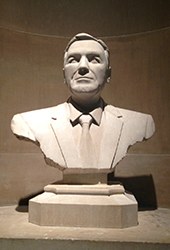
(November 6, 1917 - February 4, 2016)
Governor of Indiana
- Secretary of State for Indiana
- Indiana State Senator
Bust Location
Statehouse Rotunda
3rd floor, Facing west
north corner
Born
Hayden, Indiana
Edgar Doud Whitcomb was born on November 6, 1917 in Hayden, Indiana, one of four children of John and Louise Doud Whitcomb. After high school, he matriculated to Indiana University, but soon dropped out due to financial circumstances. Whitcomb joined the Army Air Corps at the outbreak of WWII, where he rose to the rank of second lieutenant and was trained as a B-17 bomber pilot in the South Pacific.1 Whitcomb was taken captive on May 7, 1942, soon after the fall of Corregidor, which resulted in Japanese control of the Philippines. Fifteen days later, he escaped the Japanese prison camp by swimming eight miles through shark-infested waters. He was soon recaptured, but undeterred escaped into the jungle with the Filipino resistance.2
Following the war, Whitcomb returned to Indiana University and earned his law degree in 1950. After being admitted to the bar in 1952, Whitcomb practiced law in Seymour, North Vernon and Indianapolis for 14 years. During this time, he married Patricia Dolfuss, a former model. He served as an Indiana State Senator from 1951 to 1954, after which he made unsuccessful bids for both U.S. House and Senate seats. He was elected Secretary of State for Indiana in 1966 and Governor in 1968.3 Whitcomb was the last governor constitutionally bound to a single term in office.
Whitcomb’s gubernatorial term represents a period of intense upheaval within the Republican Party. He characterized the ‘old guard’ of Republicans, mostly made up of conservatives from rural areas of Indiana. His chief rival was House Speaker and future governor Otis R. Bowen, who represented a new, more moderate and urban-based party leadership. Friction between these two groups plagued Whitcomb’s term as governor and he never fully saw the support of his party, even as the Republicans controlled both houses by more than two-thirds majority. Taxes and spending proved to be the greatest sources of contention, stalling much of the legislation during this period.4
Despite this party infighting, Whitcomb’s administration was able to accomplish much for the infrastructure of the state. This included computerizing the Bureau of Motor Vehicles and criminal records, creating the Indiana Higher Education Commission, expanding the state highway system, and establishing a statewide medical education system5
After his gubernatorial term ended in 1986, Whitcomb returned to practicing law, and served as the director of the Mid-Atlantic World Trade Association. Upon his retirement, he took up sailing, purchasing a 30-foot sailboat and undertaking solo voyages across the Atlantic and Pacific Oceans. In 1997, Whitcomb moved to a rustic cabin in Rome, Indiana.6
Whitcomb passed away on February 4, 2016 at his home in Rome, Indiana at the age of 98. Ceremonies and a public memorial service were held at the Indiana Statehouse, which included a 19-round Howitzer cannon salute and military honors on the Statehouse lawn.
Bust History
The impetus for this bust of Governor Whitcomb came from the Friends of Ed Whitcomb, a group who raised the $125,000 to commission this piece, as well as a statue of the former governor to be placed outside the Jennings County Courthouse. Greg Harris was commissioned to sculpt the bust, which was dedicated on January 13, 2013.7 (Seymour Tribune Article; Program) It is the only bust carved of limestone in the Statehouse.8
Sculptor
Greg Harris
Greg Harris was born in Kentucky and raised in Southern Indiana. He specializes in restoring and sculpting limestone, completing preservation work on buildings throughout Indiana. Additionally, he sculpts limestone statues, including work featured on the campus of Indiana State University.9
